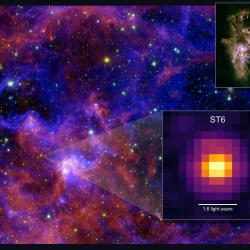Big Questions In Science- 2) Was Einstein correct?
Black holes may hold the answer to one of science’s biggest questions: Does Albert Einstein's theory of general relativity hold true? "Black holes are places where gravity has gone crazy," says Astronomy Professor Christopher Reynolds, director of the college’s Joint Space Science Institute, a partnership with NASA Goddard Space Flight Center. “They have the strongest gravitational fields in the universe. They suck in everything, even light.” Those properties make them the perfect natural laboratory to study Einstein’s predictions about gravity.
While black holes themselves are undetectable, the super-hot gases spiraling into them emit radiation that can be detected by X-ray telescopes. Reynolds seeks a better understanding of black hole dynamics by examining data from instruments like NASA’s Chandra X-ray Observatory and the European Space Agency’s X-ray Multi-Mirror Mission (XMM-Newton) that must remain in orbit thousands of miles into space to capture the X-rays.
“According to Einstein, space is like a rubber sheet that can bend,” says Reynolds. “Black holes can twist the space around them.” Using the X-ray telescope observations, Reynolds can calculate how quickly a black hole is rotating and begin to examine this “twisting of space.”
Current data supports Einstein’s theory, but most scientists predict there is a glitch somewhere. “There’s a disconnection between the two major pillars of physics—general relativity and quantum mechanics. They make fundamentally different assumptions,” says Reynolds, whose research is funded by NASA. “Most physicists think Einstein’s theory has to give.”
The search for answers is limited by current technology, which collects X-ray light from only a relatively small area and “does not allow us to track changes in the X-ray spectrum of accreting black holes in order to truly test Einstein’s assumptions,” says Reynolds, who is optimistic that future observatories will shed more light on the mysteries of black holes. He serves as a science advisor for the European Space Agency’s proposed Large Observatory for X-ray Timing (LOFT), which is now being considered for construction with a tentative launch around 2020. “With a collection area that’s nearly 100 times larger than current observatories, LOFT would enable us to study changes in the spectra of black hole systems in exquisite detail,” says Reynolds, “allowing us to conduct new tests of gravity and further our knowledge of how matter interacts with the black hole during its final ‘death plunge.’”
Writer: Beth Panitz







